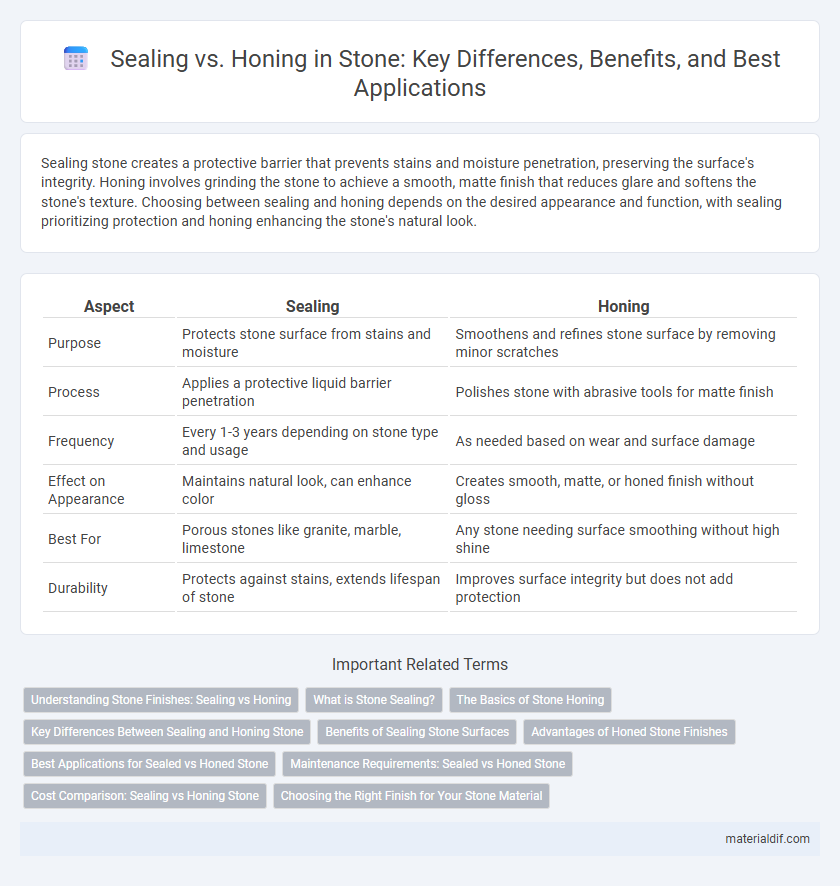Sealing stone creates a protective barrier that prevents stains and moisture penetration, preserving the surface's integrity. Honing involves grinding the stone to achieve a smooth, matte finish that reduces glare and softens the stone's texture. Choosing between sealing and honing depends on the desired appearance and function, with sealing prioritizing protection and honing enhancing the stone's natural look.
Table of Comparison
| Aspect | Sealing | Honing |
|---|---|---|
| Purpose | Protects stone surface from stains and moisture | Smoothens and refines stone surface by removing minor scratches |
| Process | Applies a protective liquid barrier penetration | Polishes stone with abrasive tools for matte finish |
| Frequency | Every 1-3 years depending on stone type and usage | As needed based on wear and surface damage |
| Effect on Appearance | Maintains natural look, can enhance color | Creates smooth, matte, or honed finish without gloss |
| Best For | Porous stones like granite, marble, limestone | Any stone needing surface smoothing without high shine |
| Durability | Protects against stains, extends lifespan of stone | Improves surface integrity but does not add protection |
Understanding Stone Finishes: Sealing vs Honing
Sealing stone creates a protective barrier that prevents moisture, stains, and dirt from penetrating porous surfaces, enhancing durability and ease of maintenance. Honing involves polishing the stone to a smooth, matte finish that reduces reflectivity and hides scratches, preserving the stone's natural texture. Selecting between sealing and honing depends on the stone type, desired aesthetic, and functional requirements for longevity and appearance.
What is Stone Sealing?
Stone sealing involves applying a protective, penetrative or topical sealant that guards natural stone surfaces from moisture, stains, and wear. This process preserves the stone's appearance and durability by creating a barrier against liquids and contaminants. Choosing the right sealant depends on the stone type and its exposure to environmental elements.
The Basics of Stone Honing
Stone honing involves gently abrading the surface to create a smooth, matte finish that enhances the stone's natural texture and color depth. Unlike sealing, which protects and repels stains by forming a barrier, honing focuses on refining the stone by removing minor imperfections and scratches. This technique is commonly applied to marble, limestone, and travertine to preserve their delicate appearance while maintaining durability.
Key Differences Between Sealing and Honing Stone
Sealing stone involves applying a protective layer that prevents moisture, stains, and dirt from penetrating porous surfaces, thereby preserving the stone's durability and appearance. Honing stone refers to the process of smoothing and dulling the surface to remove imperfections without creating a glossy finish, improving texture and preparing the stone for further treatments. Key differences between sealing and honing lie in their purpose: sealing provides a protective barrier, while honing alters the surface texture for aesthetic and functional refinement.
Benefits of Sealing Stone Surfaces
Sealing stone surfaces provides enhanced protection against stains, moisture, and surface damage by creating a barrier that repels liquids and prevents penetration. This treatment extends the lifespan of natural stone by reducing the risk of cracks, discoloration, and erosion caused by environmental factors. Regular sealing maintains the stone's aesthetic appeal, preserving its natural texture and color while facilitating easier cleaning and maintenance.
Advantages of Honed Stone Finishes
Honed stone finishes offer a smooth, matte surface that enhances slip resistance, making them ideal for high-traffic areas and wet environments. The finish minimizes the appearance of scratches and etching, preserving the stone's natural elegance without the glossy reflection of sealed surfaces. Honed stone also requires less maintenance compared to sealed stone, as it does not need frequent reapplication of sealers to maintain its durability and aesthetic appeal.
Best Applications for Sealed vs Honed Stone
Sealed stone is ideal for high-traffic areas and surfaces prone to moisture, such as kitchen countertops and bathroom floors, because the sealant creates a protective barrier against stains and water damage. Honed stone, with its smooth, matte finish, is best suited for interior design elements like fireplace surrounds and flooring in low-traffic spaces where a natural, slip-resistant texture is preferred. Choosing between sealed and honed stone depends on balancing durability needs with aesthetic preferences for specific applications.
Maintenance Requirements: Sealed vs Honed Stone
Sealed stone surfaces require periodic resealing every 1-3 years to maintain stain resistance and prevent moisture penetration, depending on the type of stone and usage frequency. Honed stone, which is left unsealed with a matte finish, demands more frequent cleaning and immediate spill management to avoid staining and etching. Proper maintenance of sealed stone involves using pH-neutral cleaners, while honed stone benefits from more vigilant care to preserve its natural texture and appearance.
Cost Comparison: Sealing vs Honing Stone
Sealing stone typically costs between $0.50 to $2 per square foot, offering an affordable protective layer that enhances durability and resistance to stains. Honing stone, involving a more labor-intensive process, generally ranges from $5 to $15 per square foot due to the precision required to create a smooth, matte finish. Choosing between sealing and honing depends on budget constraints and desired aesthetic, with sealing being cost-effective for maintenance and honing providing a higher-end surface restoration.
Choosing the Right Finish for Your Stone Material
Sealing stone enhances its resistance to stains and moisture, preserving its natural beauty and durability over time. Honing offers a smooth, matte finish that reduces glare and hides scratches while maintaining the stone's organic texture. Selecting the right finish depends on the stone type, usage area, and desired aesthetic, ensuring optimal protection and visual appeal.
Sealing vs Honing Infographic

 materialdif.com
materialdif.com